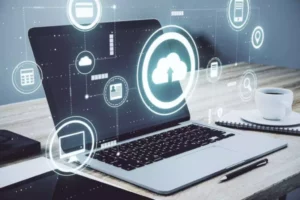Companies like Netflix, Spotify and other SaaS companies have even built their entire business models on the concept of cloud computing. The biggest problem of cloud computing is latency because of the distance between users and the data centers that host the cloud services. This has led to the development of a new technology called edge computing moves computing closer to end users.

AWS for the Edge brings the world’s most capable and secure cloud closer to your endpoints and users. AWS is the only provider that extends infrastructure, services, APIs, and tools offered in the cloud as a fully managed service to virtually any on-premises data center, co-location space, or edge facility. Examples include live video streaming in media and entertainment, online gaming, or virtual reality video feeds. Edge computing for downstream use cases focus on reducing network latency so users experience events as they take place. Edge devices monitor critical patient functions such as temperature and blood sugar levels.
IT Roadmaps Explained with Examples
The main goal of edge computing is to reduce latency requirements while processing data and saving network costs. IoT sensors can monitor machine health and identify indicators of time-sensitive maintenance issues in real-time, thanks to edge computing. The data is examined on the factory floor, and the analytics results are uploaded to centralized cloud data centers for reporting and additional analysis. Smart speakers, watches and phones all use edge computing to collect and process data while touching the physical world. IoT devices, point of sales (POS) systems, robots, vehicles and sensors can all also be edge devices if they compute locally and talk to the cloud. By processing data on a network’s edge, unnecessary data is removed early on, which means you don’t have to send data all the way between devices and the cloud for processing.

Edge computing can benefit this move to cloud, as the architecture can transfer crucial information to data centers from various points. An Edge stack, consisting of reasonable compute, storage, and analytic power, is built close to the data source or the user endpoint. This group of edge stacks distributed across the network analyze the data locally and send what needs to be further analyzed or stored in the cloud or central location, bringing down the turnaround time.
Is edge computing the future?
By processing data locally, the amount of data to be sent can be vastly reduced, requiring far less bandwidth or connectivity time than might otherwise be necessary. But this virtual flood of data is also changing the way businesses handle computing. The traditional computing paradigm built on a centralized data center and everyday internet isn’t well suited to moving endlessly growing rivers of real-world data. Bandwidth limitations, latency issues and unpredictable network disruptions can all conspire to impair such efforts.

At its simplest, edge computing brings computing resources, data storage, and enterprise applications closer to where the people actually consume the information. Edge computing is defined as the practice of processing and computing client data closer to the data source rather than on a centralized server or a cloud-based location. This article explains edge computing in detail and shares some useful best practices for edge computing in 2022.
Why is Edge Computing important?
Traditional data handling methods faced significant limitations in accommodating the exponential growth in data volume and the proliferation of internet-connected devices. In response to these challenges, edge computing introduced an innovative approach. This article delves into the transformation from conventional data processing to the fundamental principles of edge computing. We’ll explore its remarkable significance and the profound impact it has on the way data is managed and processed.
Edge computing benefits include reduced costs and faster response times, yet the architecture can introduce challenges to networks, as well. Edge computing is a distributed computing framework that brings enterprise applications closer to data sources such as IoT devices or local edge servers. This proximity to data at its source can deliver strong business benefits, including faster insights, improved response times and better bandwidth availability. Data is generated or collected in many locations and then moved to the cloud, where computing is centralized, making it easier and cheaper to process data together in one place and at scale.
Eliminates Latency
For example, a device that can monitor someone’s pulse and blood pressure can be positioned on their body and then send information to an edge-based server. Only certain information is then sent to the cloud, while most of it is handled within the edge network. Yet traditional networks weren’t built to support this type of architecture, so IT teams may require new — or at least supplemental — networking gear for the transition, Tolly said. Gear including Wi-Fi 6 access points, multi-gigabit capabilities and hyper-converged infrastructure are among trends that could benefit edge computing and IoT for enterprise networks. Additionally, autonomous vehicles interact more efficiently if they communicate with each other first, as opposed to sending data on weather conditions, traffic, accidents, or detours to a remote server. Edge computing is critical technology for ensuring their safety and ability to accurately judge road conditions.
Let’s discover the pivotal role each one of these plays in shaping the edge infrastructure. Crown Capital — a partner of Vapor IO and the largest owner of wireless infrastructure in the United States — has a lot of both, including in Chicago, Illinois, where its expansive fiber routes connect Vapor IO’s edge modules. After railroad companies used their land-grant rights to have telco partners run fiber-optic lines along rail lines, it also became a major fiber hub.
Learn About AWS
Vehicles with self-driving technology can take input from their surroundings and other vehicles and use them to make decisions. Some of the data they collect and use either comes from or gets sent to the cloud, while other data is processed at the edge. Edge servers perform many of the functions of full-fledged embedded systems data centers. They are deployed, for example, in 5G networks and are capable of hosting applications and caching content close to where end-users are doing their computing. With this topology, the data does not have to travel all the way to a remote data center for the edge device to function properly.
- Latency reduction is one of the hallmarks of edge computing, and it is made possible because of the proximity of the edge devices and where their data is stored and processed.
- As a result, it is necessary to analyze data quickly to determine the scope of your project and improve customer experience.
- Particularly for use cases that involve AI voice assistance capabilities, the technology needs go beyond computational power and data transmission speed.
- This decentralization demands decentralized processing and storage as transporting volume of traffic to and from central systems is as inefficient as it’s expensive.
- Second, given the diverse set of problems that edge computing solves, it’s unlikely that we’ll have common standards anytime soon.
Further, it would be relatively easy to spy on the activity within the network, as well as the data that is transferred throughout the network, if proper security measures are not in place for each device. If an edge device fails, there is often no redundancy in place to maintain business continuity. The end-user would have to have a backup edge device connected to the same computational and storage services. In many situations, this kind of resiliency plan would be prohibitively expensive. Soon, users could have their own personal computers, then personal devices, bringing a significant portion of computational processes to, or at least closer to, the edge. This edge computing definition refers to the environments, devices, and processes that happen at the edge of a network.
Overcoming Zero Trust Challenges with Edge Computing
Second, given the diverse set of problems that edge computing solves, it’s unlikely that we’ll have common standards anytime soon. You can’t expect the data storage standards for an oil rig and an autonomous vehicle to be the same. They are attempting to solve very different problems, and you don’t want to implement “standards” to limit what they need to do. First, seeing edge computing as a valid architecture pattern is an apparent success. We’ve understood that moving data and processing closer to the point of generation is a better approach for many use cases, and now we have the technology and bandwidth to pull it off.
In the Beginning, There Was the Server
Businesses deploying IoT in edge computing capabilities close to devices gain the prowess to respond to new data in a matter of seconds. Businesses that fail to get onboard with edge networks will miss out on acquiring many benefits in terms of cost, efficiency, and better connectivity. Accessing in-depth data from multiple locations equips businesses to deal with the demands of future customers. It enables businesses to analyze critical data in real-time without sending it thousands of miles away. Moreover, it is a crucial step forward for companies looking to create high-performance applications with low latency.
In many instances, it first looked like edge computing would be the target architecture but it turned out to make more sense to centralize more processing and data storage. Edge computing eases that burden by moving some of the processing closer to its point of origin — as close as possible to where the action occurs. Edge computing is a distributed computing framework that brings computing and data storage closer to devices, reducing the amount of data needed to move around and making responses faster.
